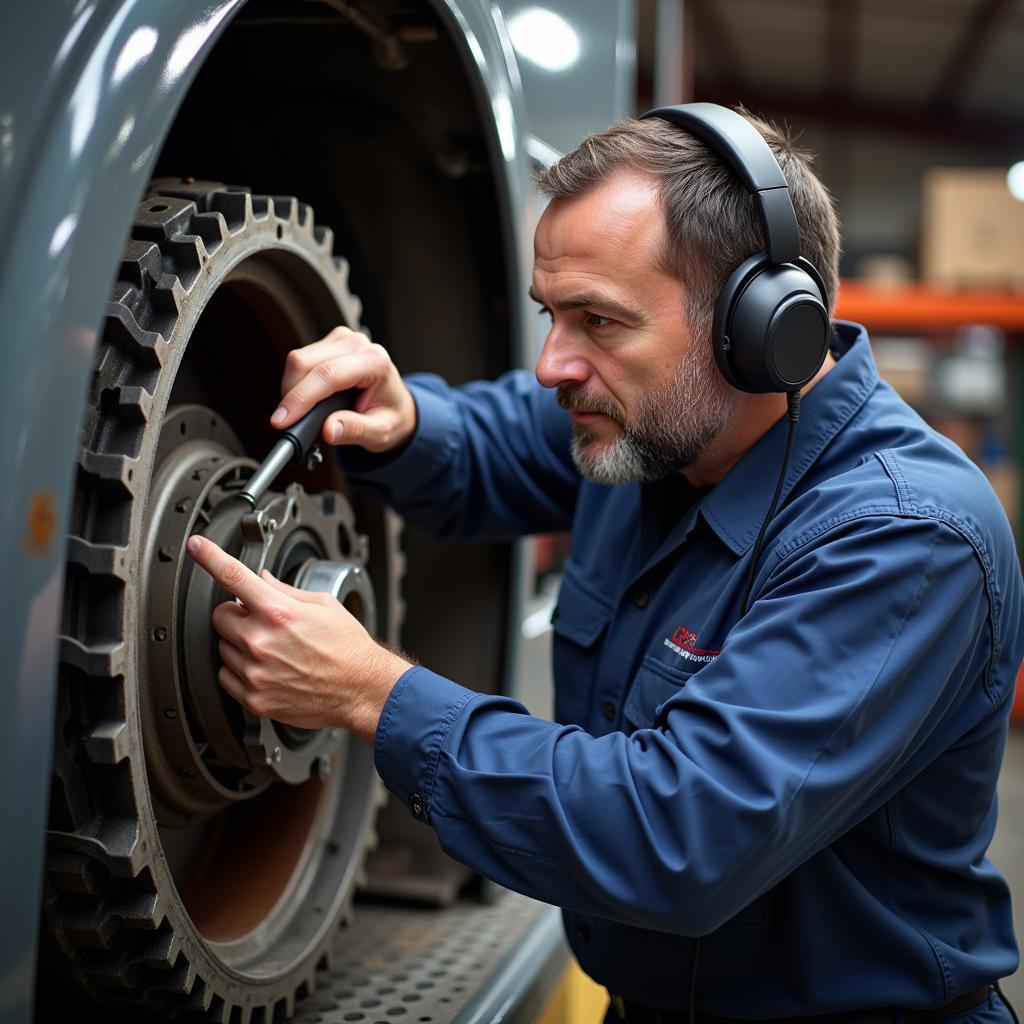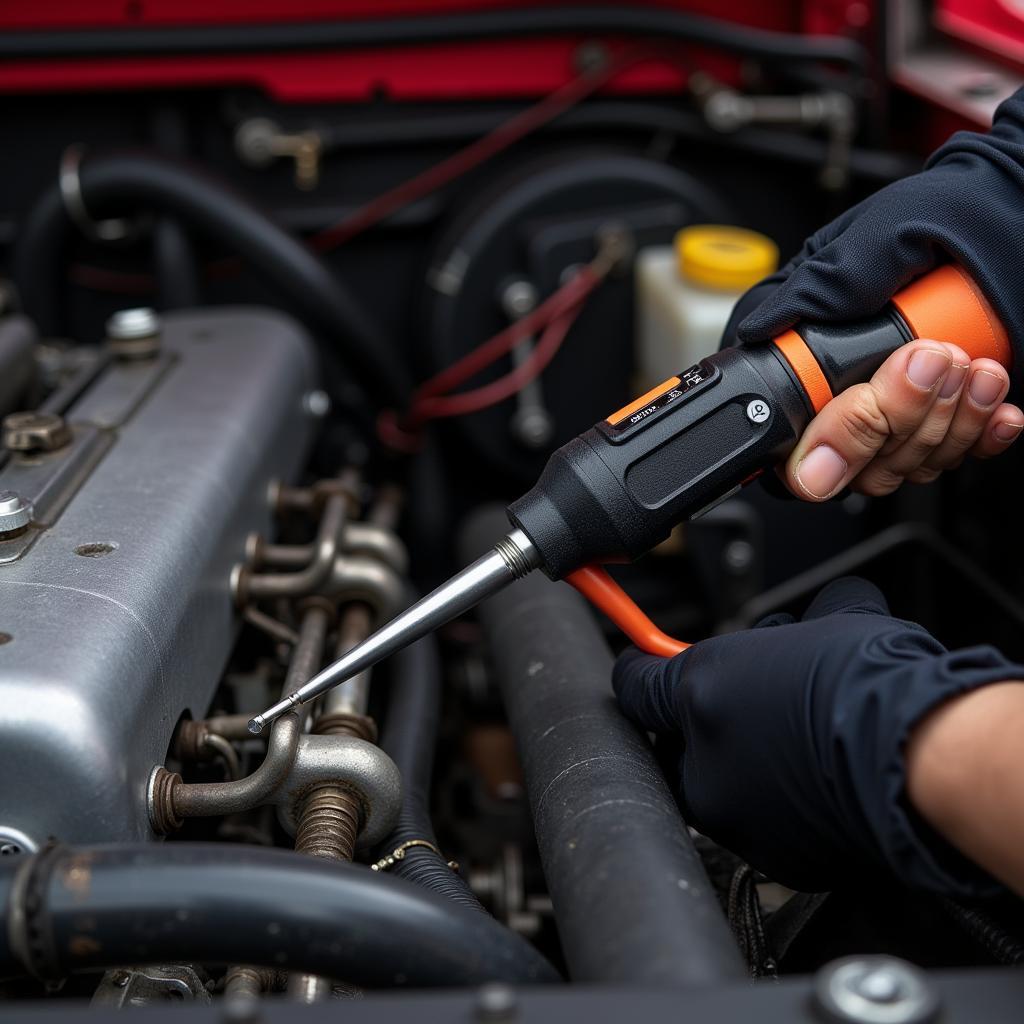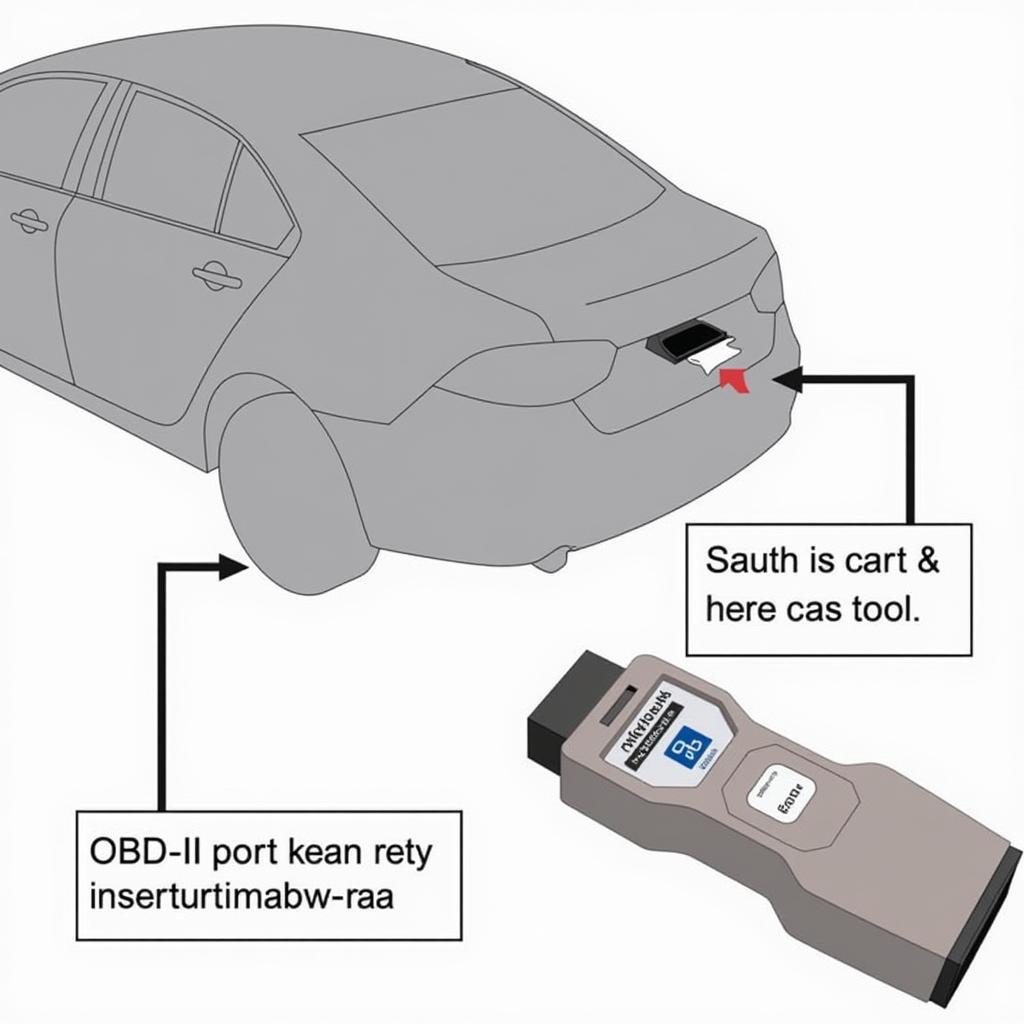Truck diagnostic tools have revolutionized the way mechanics troubleshoot issues, and among these tools, the “super ear” stands out. This tool, formally known as a mechanic’s stethoscope, is invaluable for pinpointing noises in trucks that traditional diagnostic tools might miss. Whether you’re a seasoned mechanic or a truck owner dabbling in DIY repairs, understanding how to use a truck diagnostic tool super ear can save you time, money, and frustration.
Hearing the Unheard: The Power of a Mechanic’s Stethoscope
 Mechanic Using Super Ear on Truck Engine
Mechanic Using Super Ear on Truck Engine
Unlike traditional stethoscopes used in medicine, a mechanic’s stethoscope, or “super ear,” is specifically designed to amplify sounds from engines, transmissions, differentials, and other mechanical components. This tool consists of a sensitive microphone, a set of headphones, and a probe that transmits sound waves. By placing the probe on different parts of the truck while the engine is running, mechanics can isolate noises that might indicate a specific problem.
When to Deploy Your Truck Diagnostic Tool Super Ear
 Mechanic Diagnosing Truck Transmission with Super Ear
Mechanic Diagnosing Truck Transmission with Super Ear
The beauty of a truck diagnostic tool super ear lies in its versatility. Here are just a few scenarios where this tool proves indispensable:
- Identifying Engine Noises: From a subtle ticking to a loud knocking, a super ear can help pinpoint the source of engine noises that might indicate worn bearings, valve train issues, or other internal problems.
- Diagnosing Transmission Problems: Whining, grinding, or clunking noises from the transmission can signal serious issues. A super ear can help determine if the noise originates from the transmission itself or a related component.
- Pinpointing Differential Issues: A humming or growling from the rear end often points to a differential problem. The super ear can isolate the noise and even help determine which side of the differential is affected.
- Finding Exhaust Leaks: A small exhaust leak can be difficult to locate visually. The amplified sound through the super ear makes it easier to find the leak and determine the necessary repair.
- Troubleshooting Power Steering Problems: Whining noises from the power steering system can indicate a failing pump, low fluid, or a leak. A super ear can help pinpoint the source of the problem.
Mastering Your Truck Diagnostic Tool Super Ear
 Close-up of Mechanic's Hands Using Super Ear Probe
Close-up of Mechanic's Hands Using Super Ear Probe
Using a truck diagnostic tool super ear effectively involves more than simply placing the probe on a part and listening. Here’s a step-by-step guide to help you get the most out of this tool:
- Start with Safety: Ensure the vehicle is parked on a level surface, the engine is cold, the parking brake is engaged, and the transmission is in “Park” or “Neutral.” Always wear safety glasses and gloves when working on your truck.
- Connect the Super Ear: Attach the headphones and probe to the main unit, ensuring all connections are secure.
- Begin with a Visual Inspection: Before using the super ear, perform a visual inspection of the area you’ll be troubleshooting. This can help you identify any obvious issues or potential safety hazards.
- Strategically Position the Probe: Starting with the suspected problem area, firmly press the probe against various points on the component you’re examining. Avoid touching moving parts with the probe.
- Listen Carefully: Pay attention to the volume and characteristics of the sounds you hear. Louder noises typically indicate a more severe problem.
- Move Methodically: Systematically move the probe around the suspected area, listening for changes in sound intensity or characteristics.
- Isolate the Noise: As you move the probe, try to pinpoint the exact location where the noise is loudest or most pronounced. This is likely the source of the problem.
- Compare Sounds: If possible, compare the sounds you hear to known good components or refer to online resources or repair manuals for guidance.
Choosing the Right Truck Diagnostic Tool Super Ear
The market offers a variety of truck diagnostic tool super ear options, each with unique features. Consider the following factors when choosing the right one for your needs:
- Sound Amplification: Look for a model with adjustable amplification to fine-tune the sound level for different applications.
- Probe Design: Choose a super ear with a variety of probe attachments to access different areas of the truck.
- Headphone Quality: Clear, comfortable headphones are crucial for accurately hearing and interpreting sounds.
- Durability: Opt for a well-built model that can withstand the rigors of a professional shop environment.
- Price: Truck diagnostic tool super ears are available at various price points. Determine your budget and choose a model that offers the features you need within that range.
Truck Diagnostic Tool Super Ear: Your Partner in Automotive Diagnostics
“A mechanic’s stethoscope is like having x-ray hearing,” says John Miller, a veteran diesel mechanic with over 20 years of experience. “It lets you hear problems that you might never find just by looking.” This sentiment highlights the significance of the truck diagnostic tool super ear in a mechanic’s arsenal. By amplifying the subtle whispers of a truck’s mechanical components, this tool empowers mechanics and truck owners alike to diagnose problems with greater accuracy and efficiency.
Whether you’re a seasoned mechanic or a truck enthusiast looking to expand your diagnostic capabilities, investing in a high-quality truck diagnostic tool super ear can be a game-changer.
Frequently Asked Questions about Truck Diagnostic Tool Super Ear
1. Can I use a regular stethoscope as a mechanic’s stethoscope?
While a regular stethoscope can amplify sounds to some extent, it’s not designed for the high-noise environment of an engine compartment and might not provide accurate results. A mechanic’s stethoscope is specifically engineered to handle these conditions.
2. What types of noises should I listen for with a super ear?
Listen for unusual noises such as ticking, knocking, grinding, whining, humming, or clicking. These sounds can indicate a problem with a specific component.
3. Can a super ear diagnose every truck problem?
While a super ear is a valuable diagnostic tool, it’s not a magic solution. It primarily helps pinpoint the source of noises, which then guides further inspection and testing.
4. How much does a good truck diagnostic tool super ear cost?
Prices can range from affordable models for basic use to more sophisticated options with advanced features.
5. Where can I buy a reliable truck diagnostic tool super ear?
Reputable automotive tool retailers, both online and brick-and-mortar, offer a wide selection of mechanic’s stethoscopes.
Need help choosing the right truck diagnostic tool super ear for your needs? Contact ScanToolUS today at +1 (641) 206-8880 or visit our office at 1615 S Laramie Ave, Cicero, IL 60804, USA. We’re here to help you keep your trucks running smoothly.



Pingback: Mastering Automotive Diagnostics with the ETHOS Diagnostic Tool - Car Scan Tool